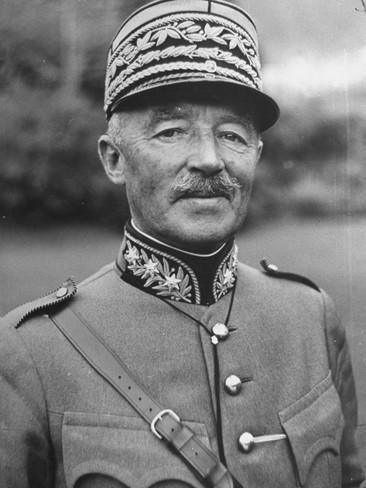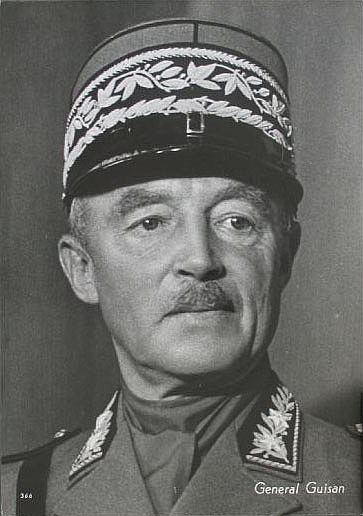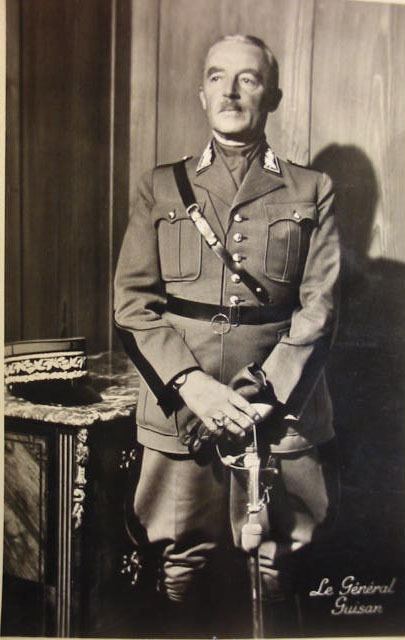Name Henri Guisan | Years of service 1894–1945 Service/branch Artillery | |
 | ||
Born 21 October 1874Mezieres ( 1874-10-21 ) Died April 7, 1960, Pully, Switzerland | ||
Commands held Military of Switzerland | ||
General henri guisan vaud swiss army world war 2 weltkrieg velonummern velovignetten
Henri Guisan ([ɑ̃ʁi ɡizɑ̃]; 21 October 1874 – 7 April 1960) was a Swiss army officer who held the office of the General of the Swiss Armed Forces during the Second World War. He was the fourth and the most recent man to be appointed to the rarely used Swiss rank of General, and was possibly Switzerland's most famous soldier. He is best remembered for effectively mobilizing the Swiss Armed Forces and Swiss people in order to prepare resistance against a possible invasion by Nazi Germany in 1940.
Contents
- General henri guisan vaud swiss army world war 2 weltkrieg velonummern velovignetten
- 100 jahre general henri guisan
- Family and career
- Defence of the nation
- Memorials
- References

100 jahre general henri guisan
Family and career

Henri Guisan was born in 1874 in Mézières, in the canton of Vaud, a Protestant part of French-speaking Switzerland. He attended school in Lausanne, and initially studied agricultural medicine. Upon entering the Swiss military in 1894, he was assigned to a horse-drawn artillery unit in Bière as a Lieutenant. He was promoted several times, reaching the rank of Colonel in 1920.
Defence of the nation

On 28 August 1939, a Federal Assembly called a United Federal Assembly to elect a General: a unique rank chosen only in time of war or national emergency. On 30 August 1939, Guisan was elected as General, by 204 votes to 21 for Jules Borel. He was given the directive to safeguard the independence of the country and to maintain the integrity of the Swiss territory. In 1939 the Swiss military could muster 430,000 men, approximately 20% of the work force. At one point, up to 850,000 Swiss soldiers were mobilized. However, Swiss military equipment was not on a par with that of the German military.

Guisan's appointment came despite his membership in the Fédération patriotique suisse, a largely pro-Nazi organisation. However, his command was dominated by conflict with the government, with the politicians continually airing German and French sentiments. Whereas the government preferred an understated and politically riskless neutrality, Guisan, charged with actually preventing invasion, opted to call for determined resistance. After the Battle of France, Germany found documents proving that Guisan had been secretly making military preparations with France, despite Swiss neutrality. The Swiss military would have been remiss in not pursuing contacts with the French based on their perception of a German threat. Nonetheless, this was politically very risky, and represented a very typical example to be seized upon by Germany to justify aggression, such as occurred prior to the German invasion of the Netherlands in World War II.

On 25 July 1940, General Guisan delivered a historic address to the entire Swiss Officer Corps assembled on the Rütli, a location charged with symbolism in Swiss Romantic nationalism by virtue of being identified as the site of the Rütlischwur of 1291. Guisan became a symbol of resistance to Nazism that was widespread amongst the Swiss public.
He made it very clear that Switzerland would resist any Nazi invasion. If they ran out of bullets they were to resort to the bayonet. He said that Switzerland would defend itself against any invader and would never surrender. The Swiss government had a decentralised structure, so even the Federal President was a relatively powerless official with no authority to surrender the country. Indeed, Swiss citizens had been instructed to regard any surrender broadcast as enemy lies and resist to the end.
As a consequence, General Guisan developed his famous Réduit National concept in summer 1940, according to which the Swiss Army would have retreated into the Alps relatively soon if attacked, but would have kept up resistance based on some sort of guerrilla and stay-behind tactics from there. The Swiss paramilitary organization Aktion Nationaler Widerstand (Resistant National Action), formed from contacts between selected army figures and conservative civilian circles, had the explicit task to persuade the civilian population to resist invaders.
However, Guisan's and Switzerland's main strategy was deterrence rather than fighting, and Germany never risked invasion. On 20 August 1945, General Guisan left his command, considering his mission to be fulfilled.
Having become a national hero by successfully avoiding war, Guisan died in Pully on 7 April 1960. He was buried on 12 April 1960 in the cemetery of Pully, with 300,000 participating at his funeral march through Lausanne. His grave is a work by Edouard-Marcel Sandoz.
Memorials
Guisan's former home Verte Rive in Pully is now used as Centre Général Guisan. His office, living room and dining room are preserved as a museum.
Memorials are at:
Numerous cities and towns in Switzerland have streets named for him: General Guisan-Strasse in Aarau, Arlesheim, Basel, Forch, Nussbaumen, Obersiggenthal, Reinach, Seltisberg, Winterthur, Zofingen, Zug; General Guisanstrasse in Interlaken, Jegenstorf, Leuggern; Guisanstrasse in Burgdorf, St. Gallen, Weinfelden; avenue Général-Guisan in Avenches, Fribourg, Pully, Rolle, Sierre, Vevey, Yverdon-les-Bains; rue du Général Guisan in Courroux, Mézières, Montana; Promenade Général Guisan in Morges; General Guisan-Promenade in Basel; via Henri Guisan in Bellinzona; via Generale Guisan in Balerna, Biasca, Riva San Vitale, Vacallo, Lugano; via Generale Henri Guisan in Chiasso; via Guisan in Massagno, Paradiso; Via Enrico Guisan in Mendrisio
Town squares and open spaces are named after him: Guisanplatz in Arosa, Berne, Grenchen and Thun; Guisanplatz/Place Guisan in Biel/Bienne; place Général-Guisan in Payerne and Pleigne; place du Général Henri-Guisan in Lausanne.
There is a quai du Général-Guisan on Lake Geneva in Geneva, General-Guisan-Quai on Lake Lucerne in Lucerne and Stansstad, on Lake Zurich in Zurich.
A military march titled General-Guisan-Marsch was composed in 1939 by Stephan Jaeggi.
Asteroid 1960 Guisan has been named in Guisan's honour.
